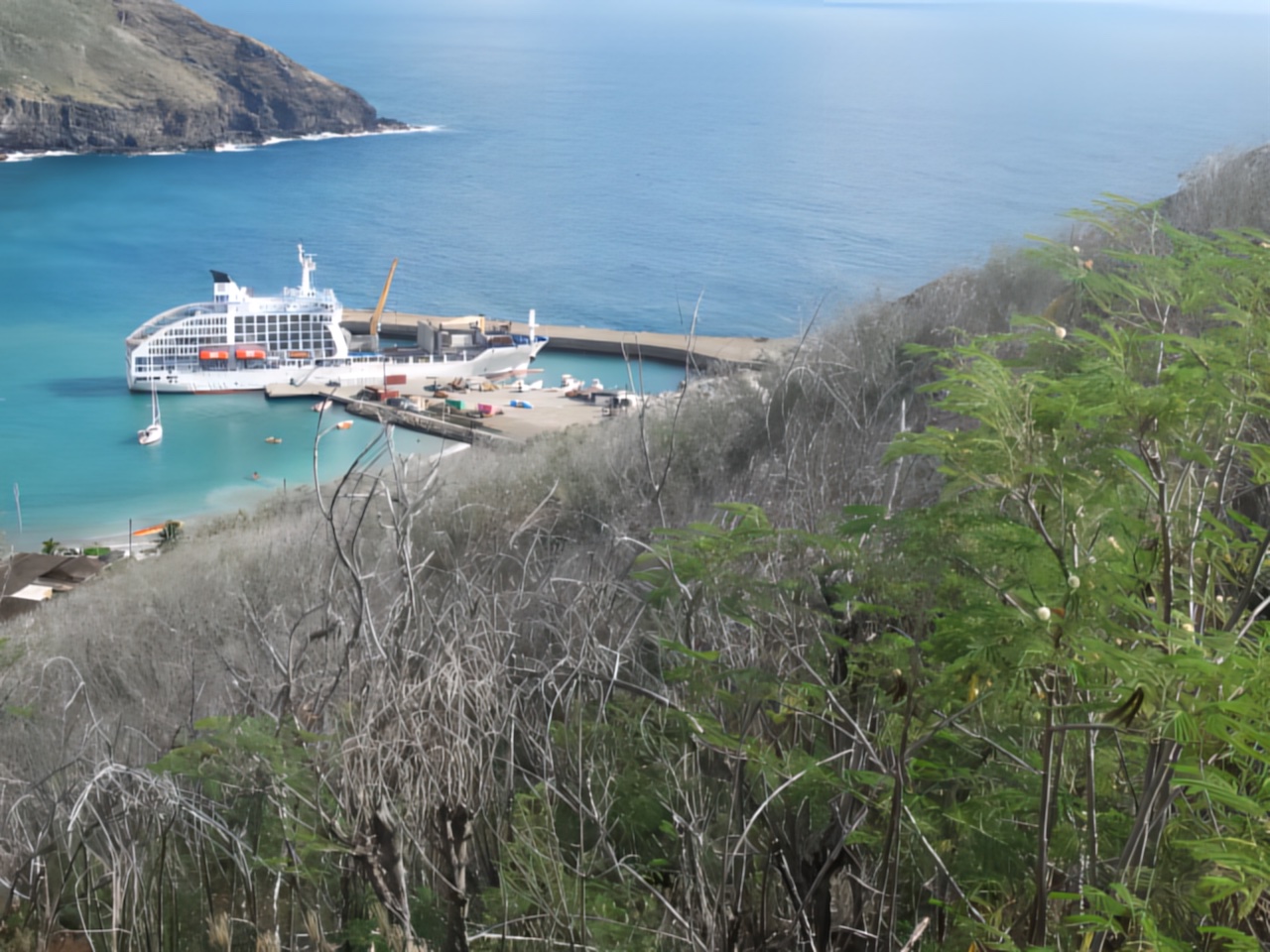
To book your Aranui 5 French Polynesia cruise contact Expedition Cruise Specialists today on 1800 90 20 80 (+61 7 4041 2101 from outside Australia).
See the Marquesas Islands Itinerary
Aranui 5 Cruise Review
Marilyn & Bob from Queensland, Australia travelled on Aranui 5’s 12-day Marquesas Islands Cruise in June 2023.
Aranui 5, is the cruise ship with a difference. Actually, it has more than one difference. Firstly, it is small, no more than 250 travellers. Secondly, it also carries cargo as well as passengers. Thirdly, it goes to islands that few other ships visit. Fourthly, it has what must be the happiest crew to be found on any ship afloat.
Aranui 5 takes its cargo and passengers to various islands in French Polynesia. Our 12-day Marquesas islands cruise took us to Rangiroa and Makatea, which are part of the Tuamotus and then on to six of the Marquesan Islands: Nuku Hiva, Ua Pou, Ua Huka, Hiva Oa, Tahuata and Fatu Hiva. We will start with the first and last islands we visited, Rangiroa and Makatea. You could not get a greater contrast in two islands that are only 30 kilometres apart. Rangiroa is the world’s second largest atoll, just a string of small islands (motus) strung around a lagoon. This lagoon is so large in fact that I did not realise we were in one. The islands on the far side are out of sight. The one that the ship stopped at was typical of atoll islands; low, only a few metres above sea level and narrow. It was only a short walk from the lagoon to the ocean.
And now the contrasting Makatea, an ex-phosphate mining island with the reef around it only extending a few metres from the shore. The bottom drops away so sharply that ships cannot anchor there. Aranui 5 drifted gently offshore with the skipper keeping it in more or less in the same place with gentle touches to the throttles and bow thrusters. Where we landed there is only a narrow stretch of flat land. Next comes the cliffs. For most of the island these rise around 200 metres, straight up. Makatea looks quite well covered from the water but I thought it would be less so when we progressed inland. This wasn’t the case and our walk across the island, just over four kilometres, was in shade most of the way. The excursion offered the choice for passengers to walk across and back, walk across and get a ride back or go over and back in a car.
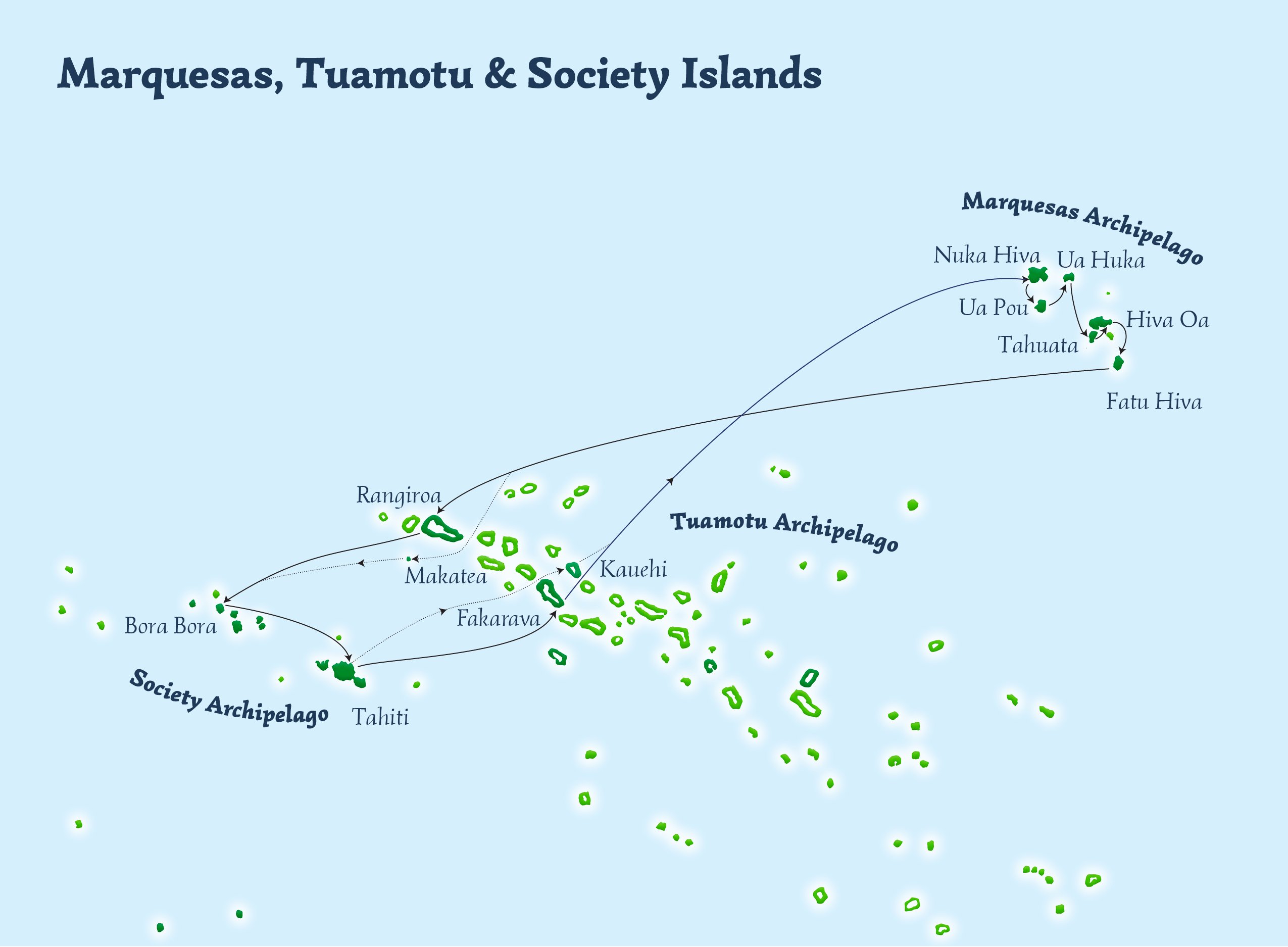
Next stop the Marquesas Islands. High, rugged and spectacular, the only variation is in the amount of green coverage.
First up, Nuku Hiva, the island which has the main town of the group. Compared with some of our later ports this was a very easy job for the skipper to bring Aranui 5 alongside the wharf. Once we loaded into a fleet of (mostly) Toyota four door utes, with extra seating in the back for another four, our convoy set off, up and down and around the island. When we were not weaving up hairpin bends, we were weaving down.
Not to be missed on this island is the archaeological site Kamuihei, where there is a giant banyan tree with a stage below. It is where a Marquesan group performed for us, and what a performance. It is not to be missed. Lunch was typical island fare of pork, goat, chicken, fish with salads and breadfruit. This was a worthwhile excursion, as long as you are not prone to car sickness.
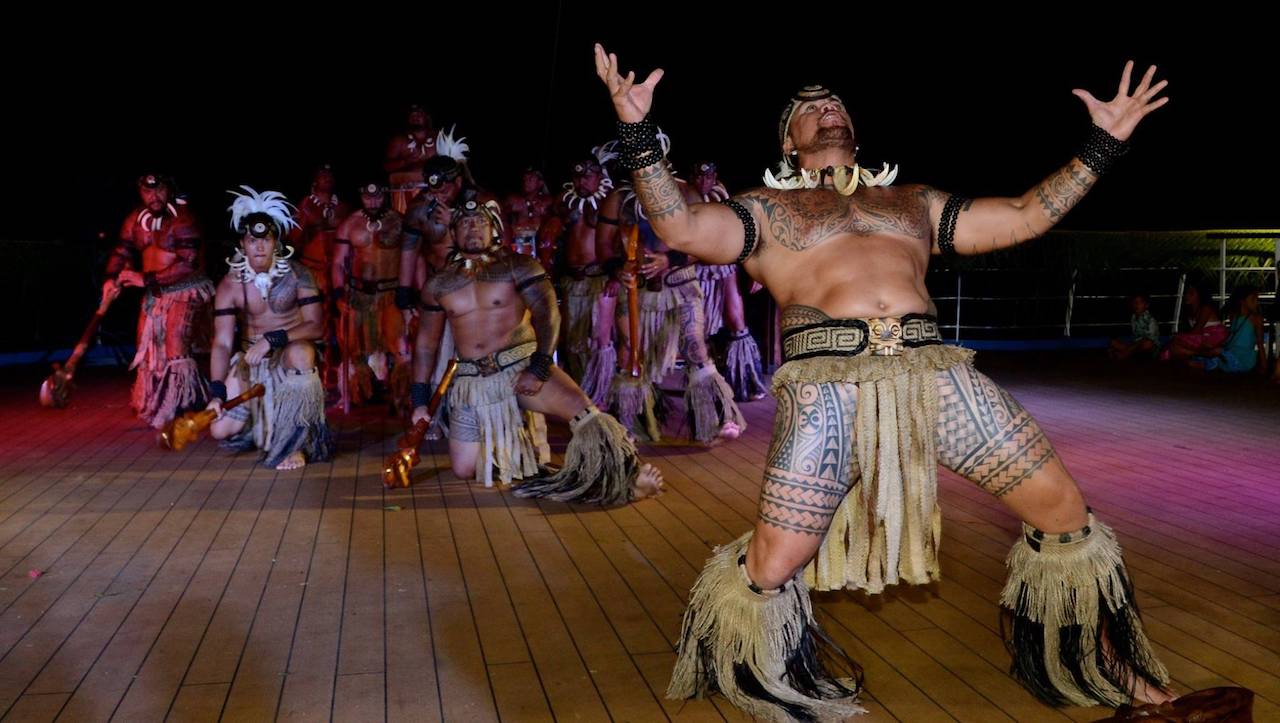
On to the island of Ua Pou. Impress your friends by giving this island’s name the correct pronunciation. It is called "Wapoh”. Once docked, it was all action stations for the cargo handling crew. Two small and two large forklifts were lowered to the dock and then the cargo was craned off. Numerous containers and various bits and pieces were taken ashore. Plenty of locals gathered on the dock to collect their goods. We found it very easy to just sit and watch the activity.
But we couldn’t sit for too long as there was walking to be done. First it was up to the cross for a good view over the village and the bay. Then down in the bay, where young school children were getting lessons on paddling the outrigger canoes. Later in the day, when school was over, a bunch of older kids came down to the dock to swim. The ship had three hawsers (thick ropes) leading from the stern to the same bollard. This gave the kids a wonderful opportunity for some fun. They would walk out on one line while hanging on to another for support. And then fall in. As I have observed on other islands, the children are lousy swimmers but are drown proof. It was good to see that the Aranui skipper was quite happy to let the kids have a lot of fun with these mooring lines.
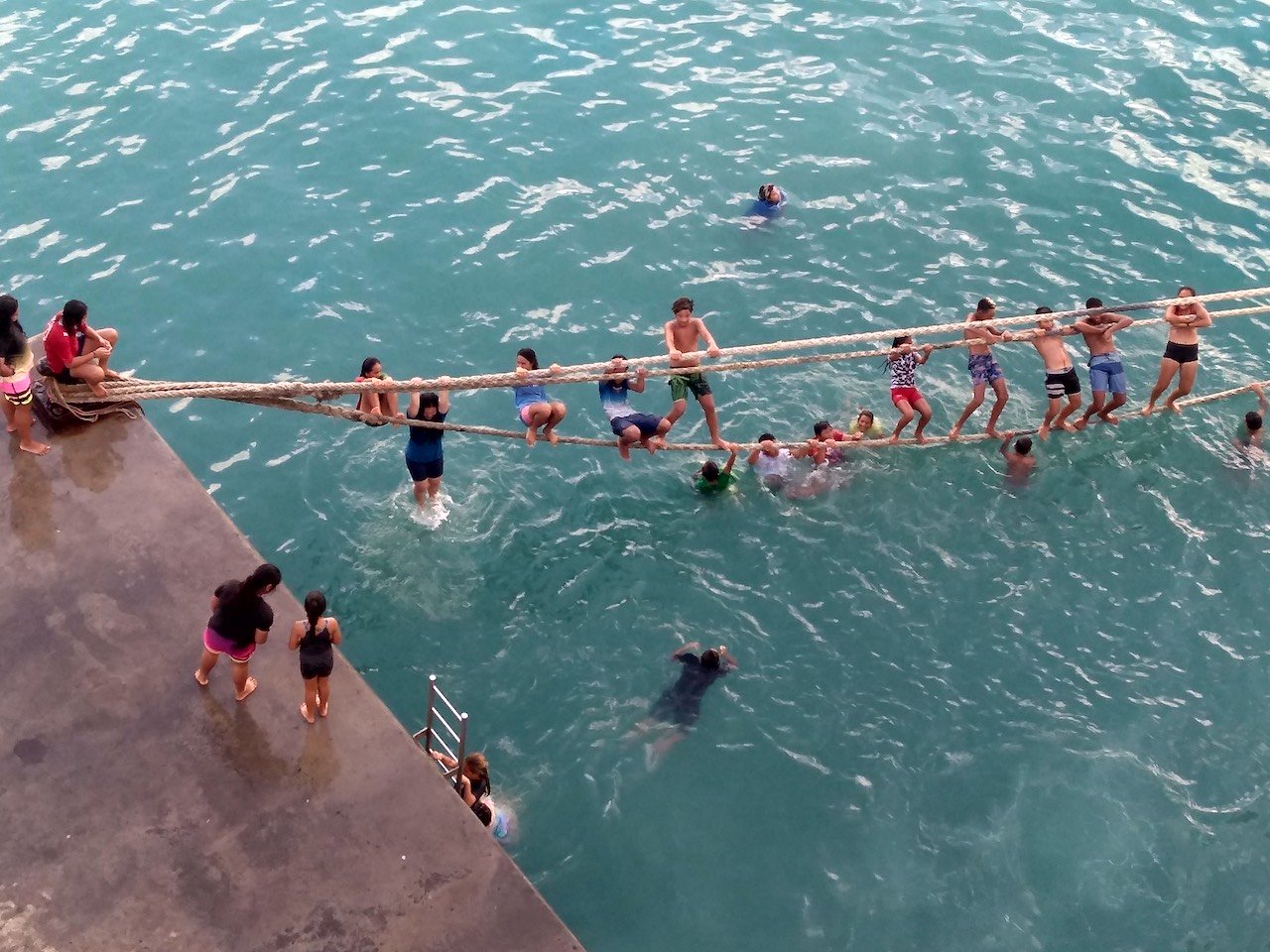
Next stop, Ua Huka. Definitely only a daylight manoeuvre to moor in the bay here. Two cargo barges were lowered into the water, one on either side, with the ship’s stern mooring lines on them. These barges then headed to the shore, allowing a crew member from each barge to leap ashore with the mooring lines to drop the loop over the bollard before jumping back on the barge. Not an easy task. The ship was now anchored securely in the middle of the bay. After watching a car being delivered ashore by barge it was time for the day’s activities. Into the 4WD utes for a drive to an arboretum (small botanic garden). Here we were introduced to some of the local trees and fruits. From there we were driven to a cultural museum and also a small sea museum. The latter I found very interesting. Then lunch and walk/drive back to the ship.
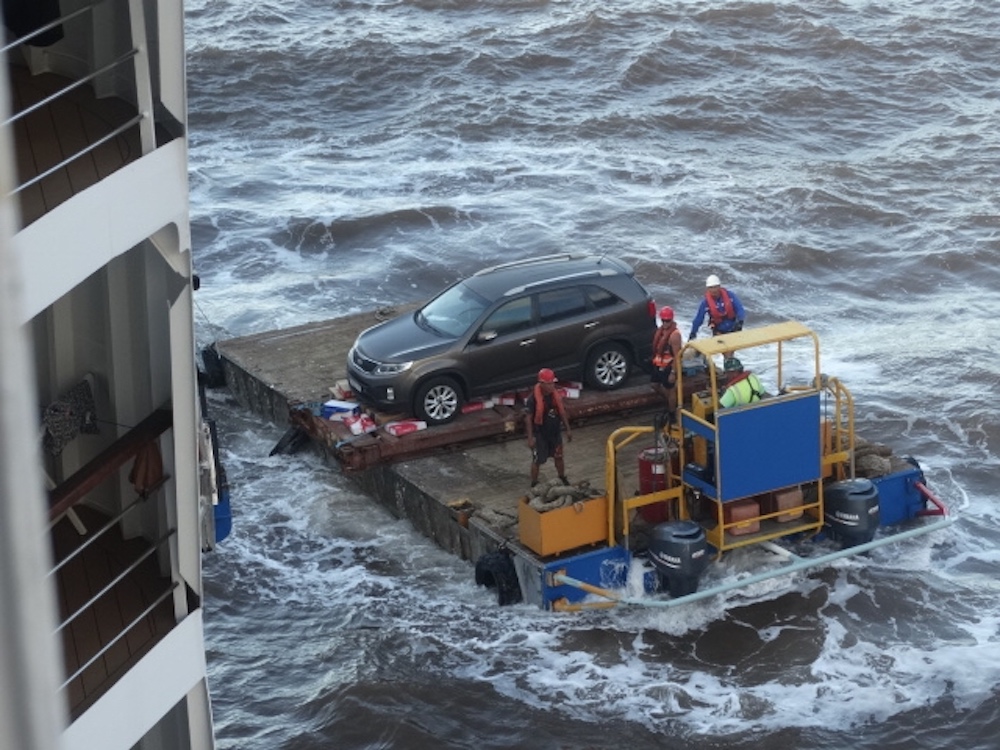
After Ua Huka we went to the Island of Hiva Oa. The day’s main activity was a visit to a cemetery, getting there either by bus or foot. Here we could see the graves of both Paul Gauguin and Jacques Brel. Then, back to the ship for lunch and a lazy afternoon. Anyone wanting to go to the village could catch the bus. We chose to go for a short walk near the dock and then watch the cargo handling. Nowhere near as uninteresting as it sounds. Next day an early start while the ship rounded the eastern most point of the island and anchored off Puamau. Anyone wanting to go could load into the 4WDs again and be taken to an archaeological site called Te I’lpona. This has been very well restored in a beautiful setting. Definitely worth the visit.
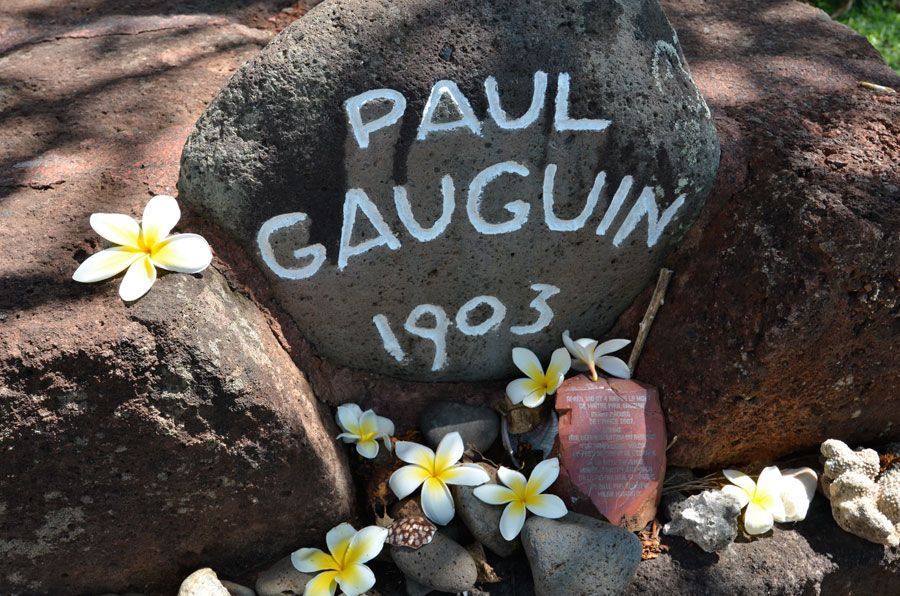
That afternoon we cruised down from Hiva Oa to Tahuata and dropped the anchor in a large bay. Into the barges once again for a visit to the village of Vaitahu and the catholic church.
Our next stop was Fatu Hiva, where we anchored in the bay off the village of Omoa. This was a day for the energetic. Those who wished to do so could walk from this village over the hills to Hanavave – a hike of some 15 kilometres. Around the half way point a picnic lunch was waiting for them. While they were walking there, the ship upped anchor and motored to Hanavave. While the ship’s literature put this down as a difficult walk, the general consensus was that it was not all that difficult, the weather was on the walker’s side as it was overcast.
Our final stop of this memorable journey was Makatea. After a busy day exploring, we motored away from the island at about 5:00 PM, heading for Papeete. Tonight was our last dinner on board, and it came with an unexpected and wonderful surprise. The dining room doors opened, and we walked in to be greeted by the kitchen and dining room staff, lined up on either side clapping us in and singing. This delightful gesture was just so Aranui. A fantastic finish to a great 12 days.
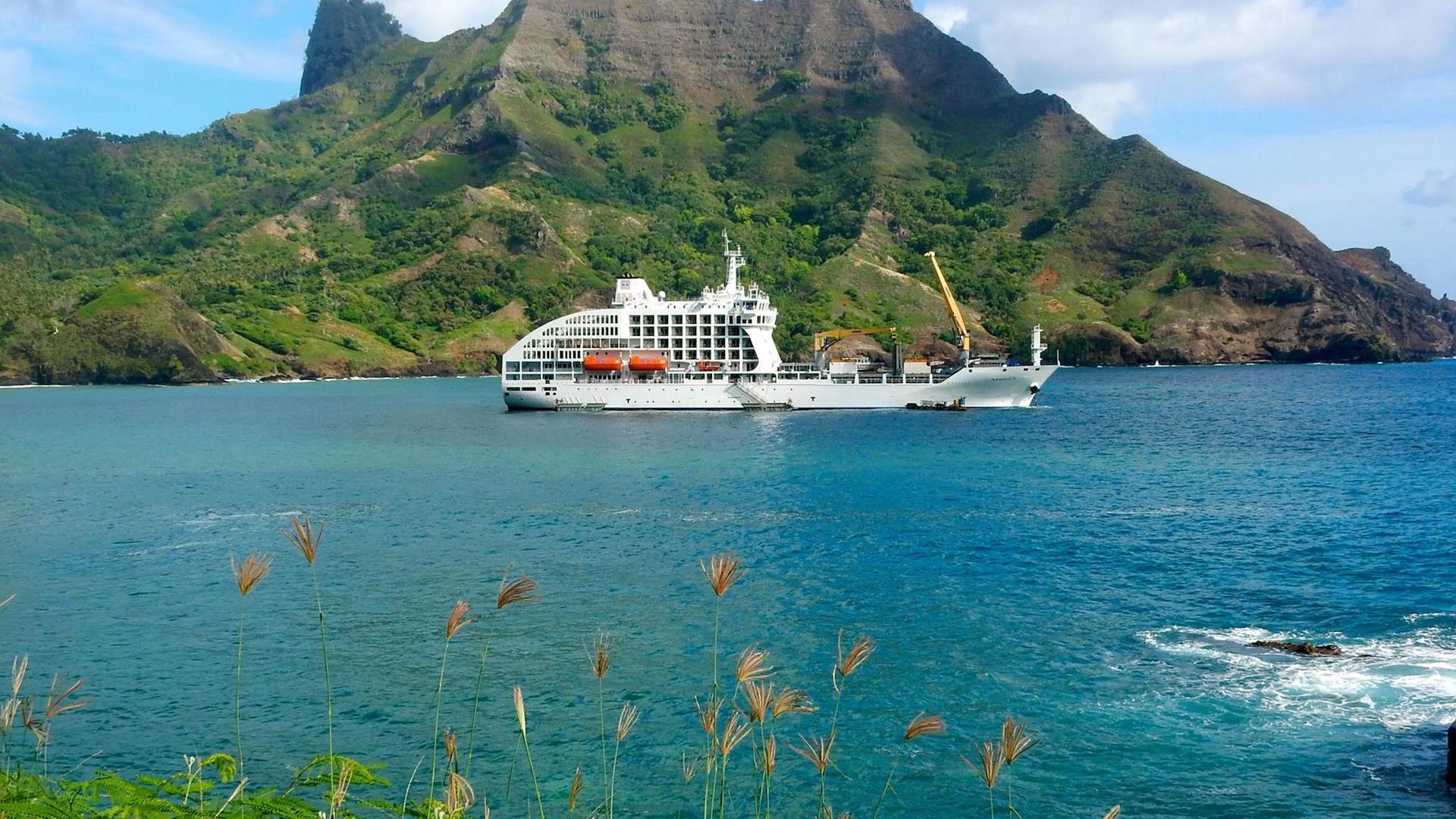
The Nitty Gritty
We learned a few things on this voyage that could be useful to other people considering this cruise.
When making the arrangements we were told that we could deposit our luggage at the dock at 9:30 AM but we could not board until 12 noon. When we dropped off our bags at about 10:30 AM, we were told we could board immediately.
Obviously, we knew we could select the type of cabin that we wanted and then, almost at the last minute, we found we could also select the deck that we wanted. If you book a cabin with a balcony we would suggest choosing the starboard side if available. The ship berths on the starboard side and passengers going ashore when anchored out also load into the barges on this side.
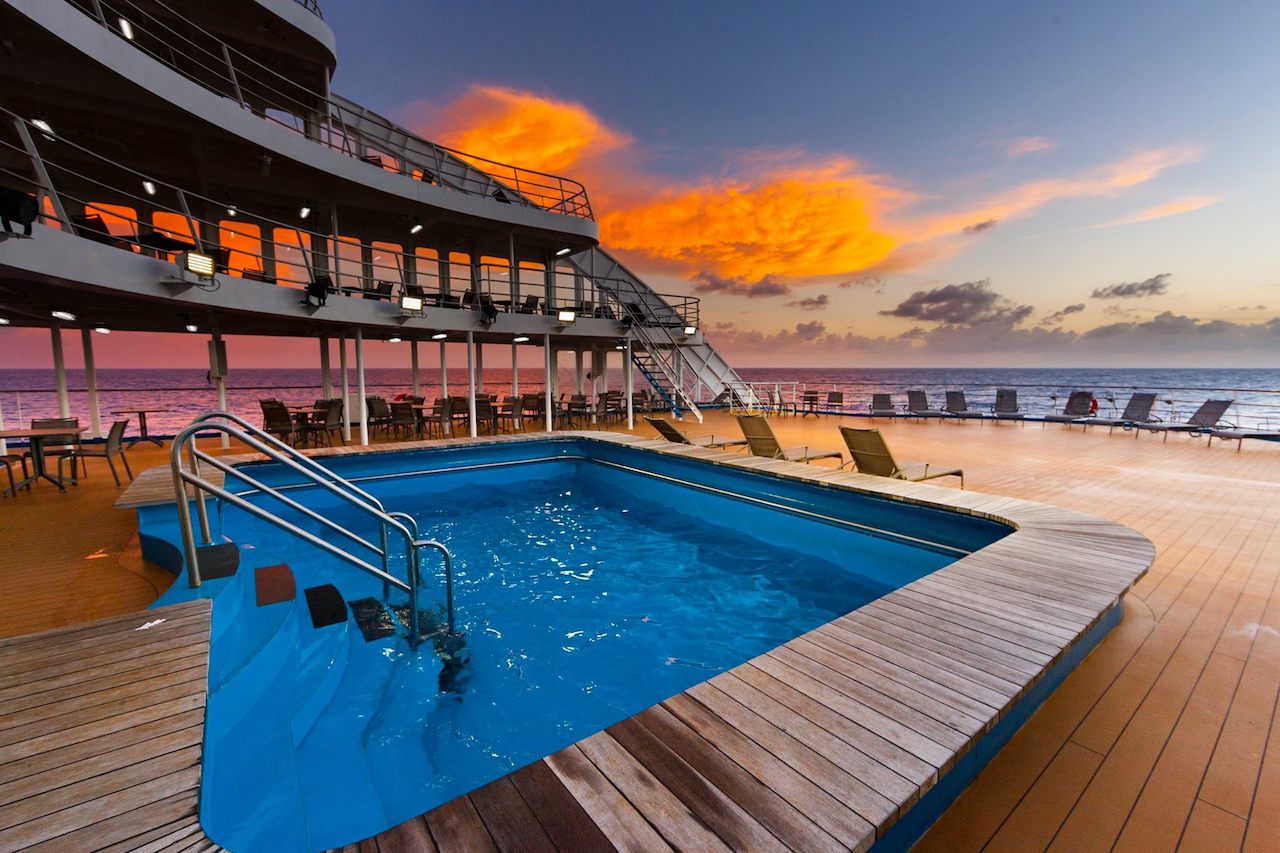
The captain and the other officers usually eat with the rest of the crew but if they are invited to dine with travellers they are happy to do so. Four of us made the invite and the skipper, 1st and 2nd officers and the chief engineer all dined with us. They were really nice people and we had an enjoyable evening with them talking about how the ship works, their families and life in general.
For travellers who like going hiking there are some organised hikes varying in length from four to 15 kilometres. On most islands there is a cross up on a hill which generally has a dirt road or track up to it. These lookouts typically provide wonderful views of the bay and the island.
Be warned if you want to purchase and bring handicrafts home to Australia you need to do your research as most are made of wood, seeds and tapa and may result in some questions from customs and quarantine!
Our Aranui 5 Cabin
Our cabin aboard Aranui 5 was a Superior Deluxe cabin, #8405, located on the starboard side of the ship. The most outstanding feature of our cabin was how soundproof it was. We were so surprised there was not even any noise when other people flushed their toilet. The only time we could hear voices was if we had our door to the balcony open and even then they were not loud. The cabin was much roomier than we thought it would be and with the extra space on the balcony it was very comfortable. There was more than ample space for our clothes, suitcases and bits and pieces. The en suite was also larger than anticipated and was well supplied with soap, shampoo and conditioner.
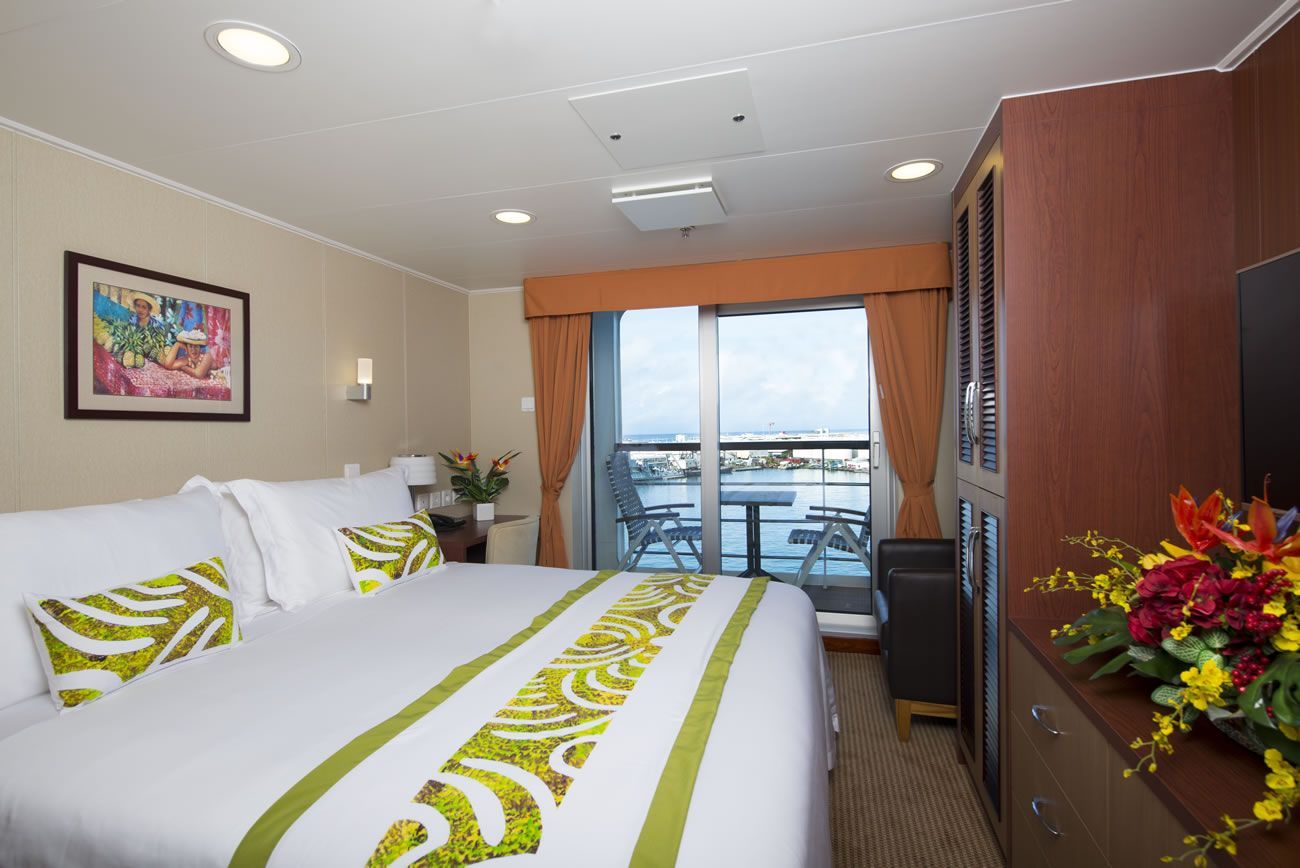
Dining Aboard Aranui 5
On our trip we were amazed at the sweets, they were exceptionally presented and the Captain shed light on this, telling us that there was an expert on board teaching their staff about desserts and presentation. How lucky were we. Fruit is always available at breakfast but if you want more it is hard to get on the islands. There is a bounty of handicrafts to buy but very little fruit, although there is plenty growing. We managed to get some occasionally.
Tahitian Poisson Cru, or ia ota in Tahitian, is the national dish and there was a demonstration on board on how to make it and a tasting after. This was the best “raw fish” dish we tasted. It was available in various iterations every time we went to restaurants on Islands for lunch.
Unless you are a very big eater, food was plentiful with three courses for lunch and dinner and a buffet for breakfast. The food was predominantly French with some pasta and local fare.
The three course lunches and dinners were really good. Everyone received the same entrée, main and sweets, there was no choice but this was fine as long as you were not a particularly fussy eater. The food was varied and very nice, we never heard anyone complain about it. Travellers with special dietary needs were catered for. The wines were all French – reds and whites. They did somewhat match wines with the meal, ie whites with fish, but we were able to change this if we wanted reds. There was one bottle shared between four travellers each meal, and after that bottle was finished you had to pay for more. I was lucky because Bob does not drink wine, so I only had to share with three people!
There were tables for two, four, six or eight people and I think the tables could be adjusted to larger groups. It wasn’t necessary to reserve a table, you sat where you wanted to. We occasionally arrived later for dinner and so chose to sit with a French couple. As we don’t have any French language skills it was up to them to test their English, which they did and were most gracious as their English was not that good.
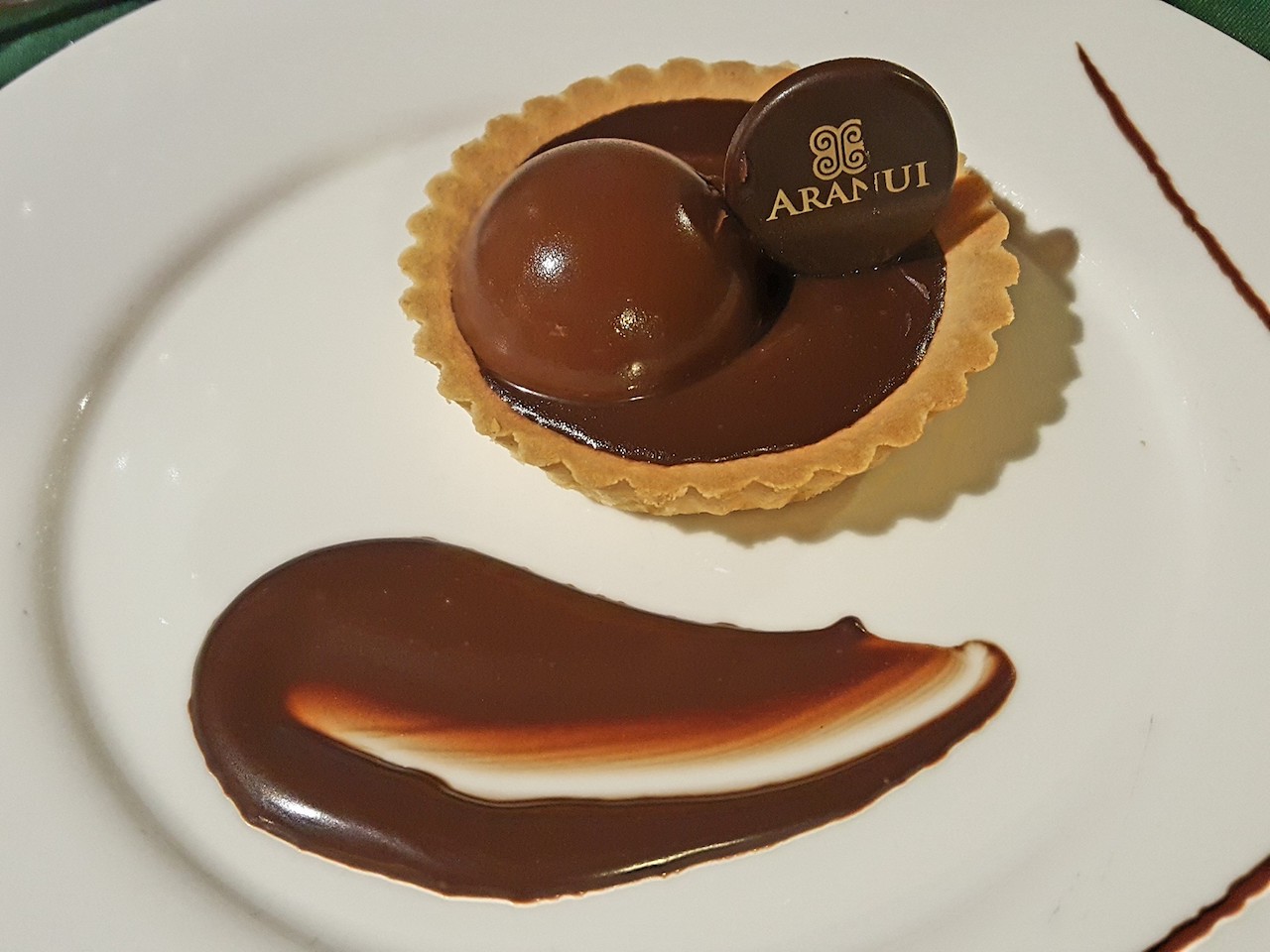
Dress Code aboard Aranui 5
Dress was casual at all times on the ship. Aranui 5’s cabins are air-conditioned with little or minimal adjustment, so if you feel the cold then you need to take this in to account. In the bar, dining room and all other inside areas of the ship are air conditioned, so once again dress according to your needs. For excursions on shore, long skirts are not a good idea because of getting in and out of the barges and the utes that go to various places. Of course, when walking light clothes are a good idea. We did not have any trouble with flies, mosquitoes, sand flies etc.
Medical Team
There was a Doctor and Nurse who not only attended to people on the ship but came along on all excursions with their very big medical kit container. One of them always went on the hikes, we were most impressed.
Aranui 5 Pool
The ship’s pool was small, which is to be expected, and people did not go in it when the ship was moving as the water sloshed about. It had good stairs to accommodate older people.
Our Verdict
It was a fantastic cruise, we really enjoyed it and would recommend other people to seriously consider doing this trip. Aranui 5 is an excellent ship going to out-of-the-way but worthwhile places to visit. The other group that contributed to us having a good time were the other passengers. They were a diverse group, from different countries and backgrounds. People were very friendly and we made some good friends who we will keep in contact with.
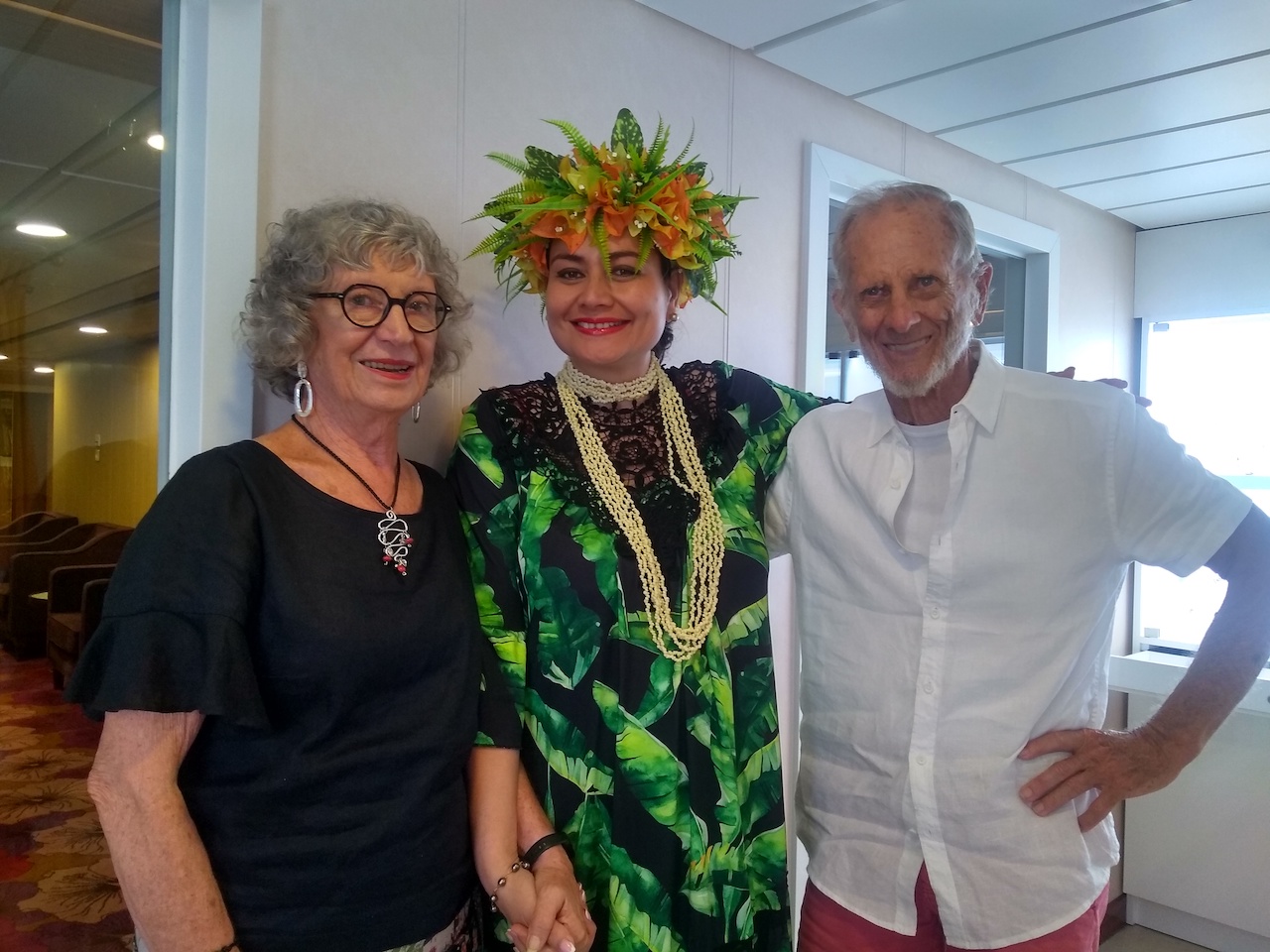
Marilyn & Bob (above with Wenda from Aranui Cruises) travelled on Aranui 5’s 12-day Marquesas Islands cruise in June 2023.
Some photography in this review has been provided by Marilyn & Bob, other images have been sourced from Aranui Cruises. Images may not be reproduced without consent from the photographers.
